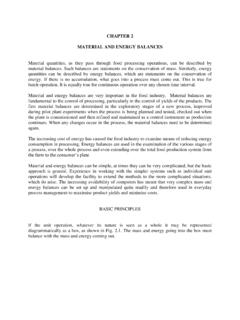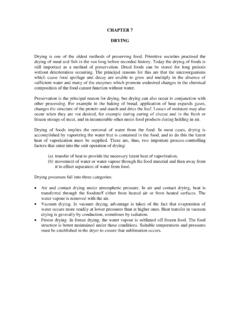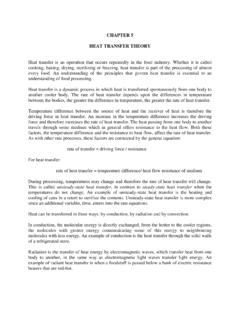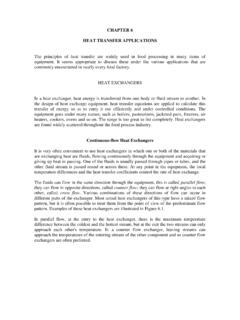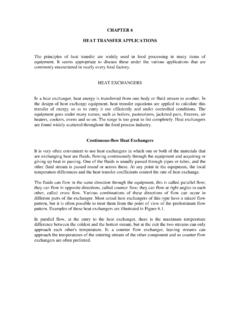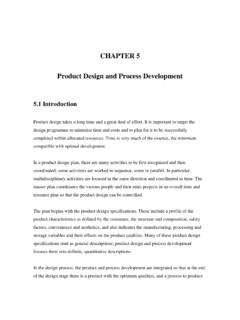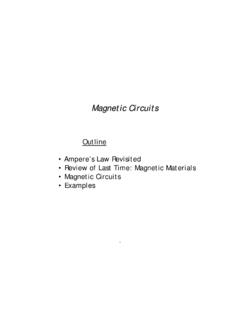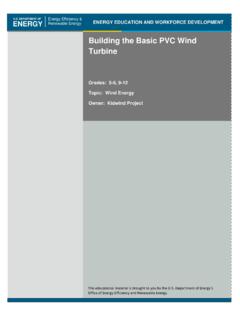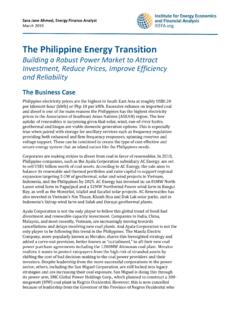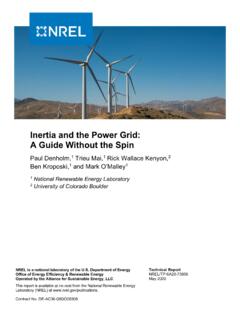Transcription of CHAPTER 2 MATERIAL AND ENERGY BALANCES - NZIFST
1 CHAPTER 2 MATERIAL AND ENERGY BALANCES MATERIAL quantities, as they pass through food processing operations, can be described by MATERIAL BALANCES . Such BALANCES are statements on the conservation of mass. Similarly, ENERGY quantities can be described by ENERGY BALANCES , which are statements on the conservation of ENERGY . If there is no accumulation, what goes into a process must come out. This is true for batch operation. It is equally true for continuous operation over any chosen time interval. MATERIAL and ENERGY BALANCES are very important in the food industry. MATERIAL BALANCES are fundamental to the control of processing, particularly in the control of yields of the products. The first MATERIAL BALANCES are determined in the exploratory stages of a new process, improved during pilot plant experiments when the process is being planned and tested, checked out when the plant is commissioned and then refined and maintained as a control instrument as production continues.
2 When any changes occur in the process, the MATERIAL BALANCES need to be determined again. The increasing cost of ENERGY has caused the food industry to examine means of reducing ENERGY consumption in processing. ENERGY BALANCES are used in the examination of the various stages of a process, over the whole process and even extending over the total food production system from the farm to the consumer s plate. MATERIAL and ENERGY BALANCES can be simple, at times they can be very complicated, but the basic approach is general. Experience in working with the simpler systems such as individual unit operations will develop the facility to extend the methods to the more complicated situations, which do arise. The increasing availability of computers has meant that very complex mass and ENERGY BALANCES can be set up and manipulated quite readily and therefore used in everyday process management to maximise product yields and minimise costs.
3 BASIC PRINCIPLES If the unit operation, whatever its nature is seen as a whole it may be represented diagrammatically as a box, as shown in Fig. The mass and ENERGY going into the box must balance with the mass and ENERGY coming out. Figure Mass and ENERGY The law of conservation of mass leads to what is called a mass or a MATERIAL balance . Mass In = Mass Out + Mass Stored Raw Materials = Products + Wastes + Stored Materials. mR = mP + mW + mS (where (sigma) denotes the sum of all terms). mR = mR1 + mR2 + mR3 = Total Raw Materials. mP = mP1 + mP2 + mP3 = Total Products. mw = mW1 + mW2 + mW3 = Total Waste Products. ms = mS1 + mS2 + mS3 = Total Stored Products. If there are no chemical changes occurring in the plant, the law of conservation of mass will apply also to each component, so that for component A: mA in entering materials = mA in the exit materials + mA stored in plant.
4 For example, in a plant that is producing sugar, if the total quantity of sugar going into the plant is not equalled by the total of the purified sugar and the sugar in the waste liquors, then there is something wrong. Sugar is either being burned (chemically changed) or accumulating in the plant or else it is going unnoticed down the drain somewhere. In this case: (mAR ) = ( mAP + mAW + mAS+ mAU ) where mAU is the unknown loss and needs to be identified. So the MATERIAL balance is now: Raw Materials = Products + Waste Products + Stored Products + Losses where Losses are the unidentified materials. Just as mass is conserved, so is ENERGY conserved in food-processing operations. The ENERGY coming into a unit operation can be balanced with the ENERGY coming out and the ENERGY stored. ENERGY In = ENERGY Out + ENERGY Stored ER = EP + EW + EL + ES where: ER = ER1 + ER2 + ER3 +.
5 = Total ENERGY Entering EP = EP1 + EP2 + EP3 + .. = Total ENERGY Leaving with Products EW = EW1 +EW2 + EW3 + .. = Total ENERGY Leaving with Waste Materials EL = EL1 + EL2 + EL3 + .. = Total ENERGY Lost to Surroundings ES = ES1 + ES2 + ES3 + .. = Total ENERGY Stored ENERGY BALANCES are often complicated because forms of ENERGY can be interconverted, for example mechanical ENERGY to heat ENERGY , but overall the quantities must balance . MATERIAL BALANCES The first step is to look at the three basic categories: materials in, materials out and materials stored. Then the materials in each category have to be considered whether they are to be treated as a whole, a gross mass balance , or whether various constituents should be treated separately and if so what constituents.
6 To take a simple example, it might be to take dry solids as opposed to total MATERIAL ; this really means separating the two groups of constituents, non-water and water. More complete dissection can separate out chemical types such as minerals, or chemical elements such as carbon. The choice and the detail depend on the reasons for making the balance and on the information that is required. A major factor in industry is, of course, the value of the materials and so expensive raw materials are more likely to be considered than cheaper ones,. and products than waste materials. Basis and Units Having decided which constituents need consideration, the basis for the calculations has to be decided. This might be some mass of raw MATERIAL entering the process in a batch system, or some mass per hour in a continuous process.
7 It could be: some mass of a particular predominant constituent, for example mass BALANCES in a bakery might be all related to 100 kg of flour entering; or some unchanging constituent, such as in combustion calculations with air where it is helpful to relate everything to the inert nitrogen component; or carbon added in the nutrients in a fermentation system because the essential ENERGY relationships of the growing micro-organisms are related to the combined carbon in the feed; or the essentially inert non-oil constituents of the oilseeds in an oil-extraction process. Sometimes it is unimportant what basis is chosen and in such cases a convenient quantity such as the total raw materials into one batch or passed in per hour to a continuous process are often selected. Having selected the basis, then the units may be chosen such as mass, or concentrations which can be by weight or can be molar if reactions are important.
8 Total mass and composition MATERIAL BALANCES can be based on total mass, mass of dry solids, or mass of particular com-ponents, for example protein. EXAMPLE Constituent balance of milk Skim milk is prepared by the removal of some of the fat from whole milk. This skim milk is found to contain water, protein, carbohydrate, fat and ash. If the original milk contained fat, calculate its composition, assuming that fat only was removed to make the skim milk and that there are no losses in processing. Basis: 100 kg of skim milk. This contains, therefore, kg of fat. Let the fat which was removed from it to make skim milk be x kg. Total original fat = (x + ) kg Total original mass = (100 + x) kg and as it is known that the original fat content was so x + = 100 + x whence x + = (l00 + x ) x = kg So the composition of the whole milk is then: fat = , water = %, protein = = %, carbohydrate = = and ash = Total composition: water , carbohydrate , fat , protein , ash Concentrations Concentrations can be expressed in many ways: weight/ weight (w/w), weight/volume (w/v), molar concentration (M), mole fraction.
9 The weight/weight concentration is the weight of the solute divided by the total weight of the solution and this is the fractional form of the percentage composition by weight. The weight volume concentration is the weight of solute in the total volume of the solution. The molar concentration is the number of moles (molecular weights) of the solute in a volume of the solution, in this book expressed as kg mole in 1 m3 of the solution. The mole fraction is the ratio of the number of moles of the solute to the total number of moles of all species present in the solution. Notice that in process engineering, it is usual to consider kg moles and in this book the term mole means a mass of the MATERIAL equal to its molecular weight in kilograms. In this book, percentage signifies percentage by weight (w/w) unless otherwise specified.
10 EXAMPLE Concentrations A solution of common salt in water is prepared by adding 20 kg of salt to 100 kg of water, to make a liquid of density 1323 kg m-3. Calculate the concentration of salt in this solution as a (a) weight fraction, (b) weight/volume fraction, (c) mole fraction, (d) molal concentration. (a) Weight fraction: 20 = 100 + 20 % weight/weight = (b) Weight/volume: A density of 1323kgm-3 means that 1m3 of solution weighs 1323kg, but 1323kg of salt solution contains: 20 x 1323 kg salt = kg salt m-3 100 + 20 and so 1 m3 solution contains kg salt. Weight/volume fraction = = 1000 and so % weight/volume = (c) Moles of water = 100 = 18 Moles of salt = 20 = Mole fraction of salt = + and so mole fraction of salt = (d) The molar concentration (M) is = moles in 1 m3.
